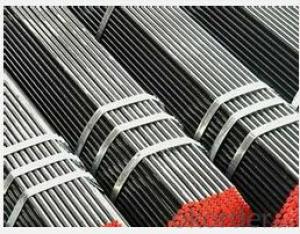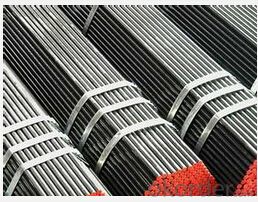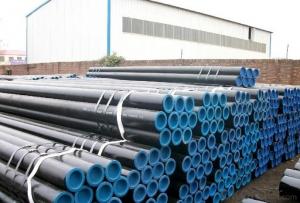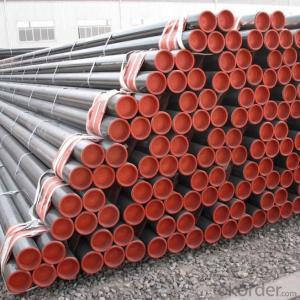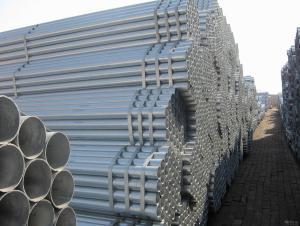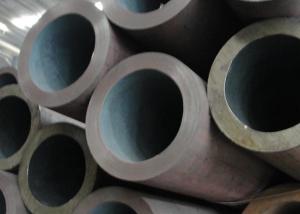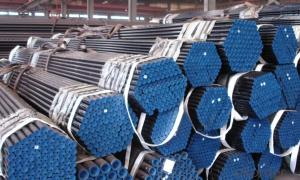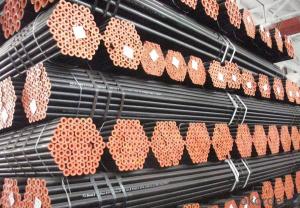Seamless steel tubes for high-pressure chemical fertilizer
- Loading Port:
- China Main Port
- Payment Terms:
- TT OR LC
- Min Order Qty:
- -
- Supply Capability:
- -
OKorder Service Pledge
OKorder Financial Service
You Might Also Like
Seamless steel tubes for high-pressure chemical fertilizer processmg equipmentStandard: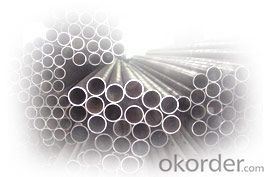
GB6479 Chinese national standard
Application:
Seamless steel tubes for high-pressure chemical fertilizer processing equipment and pipelines thereof
Model No.of steel tubes:
10、20、16Mn、10MoWVNb、15CrMo、1Cr5Mo、12 Cr2Moetc
.Diamensional tolerances:
|
|
| ||
Cold-rolled tubes | Tube sizes(mm) | Tolerances(mm) | Tube sizes (mm) | Tolerances(mm) |
>30~50 | ±0.3 | ≤30 | ±10% | |
>50~219 | ±0.8% | |||
Hot-rolled tubes | >219 | ±1.0% | >20 | ±10% |
Mechanical properties:
标准 | 牌号 | 抗拉强度(MPa) | 屈服强度(MPa) | 伸长率(%) | 冲击功(J) | 低温冲击Akv |
GB6479 | 10 | 335~490 | ≥205 | ≥24 | / | -20℃≥18 |
20 | 410~550 | ≥245 | ≥24 | ≥39 | -20℃≥18 | |
16Mn | 490~670 | ≥320 | ≥21 | ≥47 | -40℃≥21 | |
10MoWVNb | 470~670 | ≥295 | ≥19 | ≥62 | ||
15CrMo | 440~640 | ≥235 | ≥21 | ≥47 | ||
1Cr5Mo | 390~590 | ≥195 | ≥22 | ≥94 | ||
12 Cr2Mo | 450~600 | ≥280 | ≥20 | ≥38 |
Chemical composition:
Standard codes | Models of steel tubes | Chemical compositions(%) | |||||||
C | Si | Mn | P | S | Cr | Mo | Ni | ||
GB 6479 | 10 | 0.07~0.14 | 0.17~0.37 | 0.35~0.65 | ≤0.030 | ≤0.030 | / | / | / |
20 | 0.17~0.24 | 0.17~0.37 | 0.35~0.65 | ≤0.030 | ≤0.030 | / | / | / | |
16Mn | 0.12~0.20 | 0.20~0.60 | 1.20~1.60 | ≤0.030 | ≤0.030 | ||||
10MoWVNb | 0.07~0.13 | 0.50~0.80 | 0.50~0.80 | ≤0.030 | ≤0.030 | / | 0.60~0.90 | / | |
15CrMo | 0.12~0.18 | 0.17~0.37 | 0.40~0.70 | ≤0.030 | ≤0.030 | 0.80~1.10 | 0.40~0.55 | / | |
1Cr5Mo | ≤0.15 | ≤0.50 | ≤0.60 | ≤0.030 | ≤0.030 | 4.00~6.00 | 0.45~0.60 | ≤0.60 | |
12 Cr2Mo | 0.80~0.15 | ≤0.50 | 0.40~0.70 | ≤0.030 | ≤0.030 | 2.0~2.50 | 0.90~1.20 | ||
NOTE:the residual contents of the elements for the steel 10:Ni≤0.25%、Cr≤0.15%、Cu≤0.20%
the residual contents of the elements for the steel 20:Ni≤0.25%、Cr≤0.25%、Cu≤0.20%、Mo≤0.15%、V≤0.08%
the residual contents of the elements for the steel Ni≤0.30%、Cr≤0.30%、Cu≤0.20%
- Q: What are the different methods of pipe protection for steel pipes?
- Steel pipes can be protected in various ways, each with its own purpose and level of defense. Some commonly used methods include: 1. Coatings: To shield steel pipes from corrosion and environmental factors, coatings are applied to the outer surface. These can be paints, epoxies, or polymers that create a barrier between the pipe and its surroundings, preventing contact with corrosive elements. 2. Wrapping: Another method involves using materials like tape or shrink wrap to cover the steel pipe, providing a physical barrier against moisture, chemicals, and corrosive substances. Wrapping is often combined with coatings to enhance protection. 3. Cathodic Protection: This electrochemical method safeguards steel pipes from corrosion by connecting them to a sacrificial anode, typically made of zinc or magnesium. The anode corrodes instead of the pipe, preventing deterioration. It is commonly used for buried or submerged pipelines. 4. Thermal Insulation: Steel pipes exposed to extreme temperatures can be protected with thermal insulation. Materials like foam or mineral wool are applied around the pipe to minimize heat transfer. This is particularly important for pipes carrying hot fluids or in harsh weather conditions. 5. Vibration Dampening: Vibrations can damage steel pipes by causing stress and fatigue. To counter this, techniques like vibration damping pads or supports and clamps can be used. These methods absorb and dissipate the energy generated by vibrations, reducing the risk of pipe failure. 6. Concrete Coating: For pipelines installed underwater or in highly corrosive environments, concrete coating is often employed. A layer of concrete or cement-based mortar is applied to the steel pipe, providing both mechanical protection and resistance to corrosion. Choosing the appropriate method of pipe protection depends on the specific application, environmental conditions, and desired level of defense. Regular inspection and maintenance are also crucial in maintaining the long-term integrity of steel pipes.
- Q: Can steel pipes be bent or curved?
- Yes, steel pipes can be bent or curved using specialized equipment and techniques such as pipe bending machines or hydraulic bending.
- Q: What is the process of spiral steel tube production?
- 1. open panel inspection: after the steel plate is opened, the product line is entered, and the ultrasonic examination of the whole plate is carried out first.2., flat milling: through the anvil machine to make the original coiled steel flat, and then through the milling machine on the edge of the steel plate two sides milling, so as to achieve the required plate width, plate edge parallelism and groove shape.
- Q: Can steel pipes be used for structural supports?
- Yes, steel pipes can be used as structural supports due to their high strength, durability, and ability to withstand heavy loads. They are commonly used in construction for applications such as columns, beams, and braces, providing stability and support to various structures.
- Q: How are steel pipes used in the construction of high-rise buildings?
- Steel pipes are commonly used in the construction of high-rise buildings for various purposes, including structural support, plumbing, and fire protection. These pipes provide strength and durability to support the weight of the building, allowing for taller structures. They are used to create the building's framework, as well as for the distribution of water, gas, and other utilities throughout the building. Additionally, steel pipes are often used for fire sprinkler systems, providing a reliable and efficient method of fire protection in high-rise buildings.
- Q: How are steel pipes used in high-rise buildings?
- Steel pipes are used in high-rise buildings for various purposes, including structural support, plumbing, and HVAC systems. They provide the necessary strength and durability to withstand the weight and forces exerted on tall buildings, while also facilitating the efficient distribution of water, gas, and air throughout the entire structure.
- Q: How are steel pipes used in the construction of water supply systems?
- Steel pipes are commonly used in the construction of water supply systems due to their durability, strength, and resistance to corrosion. They are used for transporting water from sources such as reservoirs and wells to treatment plants, and then distributing it to homes, buildings, and other structures. Steel pipes are also used for transporting wastewater and sewage. Their ability to withstand high pressure and extreme weather conditions makes them ideal for ensuring a reliable and long-lasting water supply infrastructure.
- Q: How are steel pipes used in the manufacturing of bridges?
- Steel pipes are commonly used in the manufacturing of bridges as they provide structural support and stability. They are used for various purposes such as creating the framework, supporting the weight of the bridge, and constructing the foundations. Additionally, steel pipes are also used in the construction of bridge railings and barriers, ensuring safety for pedestrians and vehicles.
- Q: What are the different methods of joining steel pipes together?
- There are several methods of joining steel pipes together, each with its own advantages and disadvantages. 1. Welding: This is the most common and widely used method of joining steel pipes. It involves heating the ends of the pipes and applying pressure to fuse them together. Welding provides a strong and durable joint, but it requires skilled labor and specialized equipment. 2. Threaded connections: Steel pipes can also be joined by threading the ends and using threaded fittings to connect them. This method is relatively easy and quick, but it may not be as strong as welding and can be prone to leakage if not properly sealed. 3. Flanged connections: Flanges are used to connect pipes by bolting them together. This method allows for easy disassembly and reassembly, making it suitable for applications that require frequent maintenance or repair. Flanged connections are also highly resistant to leakage. 4. Compression fittings: Compression fittings are used to join steel pipes by compressing a ring or ferrule onto the pipe, creating a tight seal. This method is simple and does not require heat or welding, making it ideal for applications where heat or sparks are not permissible. 5. Grooved connections: Grooved connections involve cutting grooves into the pipe ends and using mechanical couplings to secure them together. This method is fast, reliable, and allows for easy assembly and disassembly. Grooved connections are commonly used in fire protection systems. 6. Brazing: Similar to welding, brazing involves heating the pipe ends and adding a filler material to join them together. This method is often used for smaller diameter pipes and provides a strong joint. However, it requires the use of a high-temperature torch and skilled labor. Each of these methods has its own advantages and is suitable for different applications. The choice of joining method depends on factors such as the required strength, ease of installation, maintenance requirements, and the type of pipe being used.
- Q: Can steel pipes be used for conveying hazardous materials?
- Yes, steel pipes can be used for conveying hazardous materials due to their high strength and resistance to corrosion.
Send your message to us
Seamless steel tubes for high-pressure chemical fertilizer
- Loading Port:
- China Main Port
- Payment Terms:
- TT OR LC
- Min Order Qty:
- -
- Supply Capability:
- -
OKorder Service Pledge
OKorder Financial Service
Similar products
Hot products
Hot Searches
Related keywords
